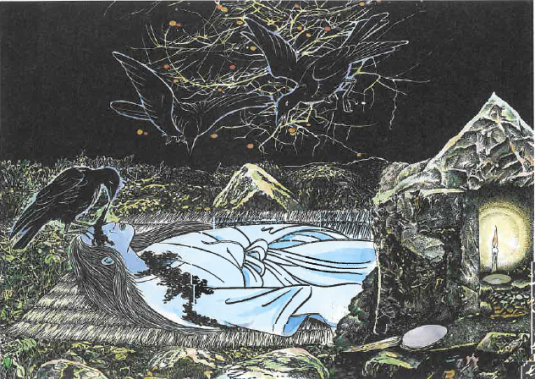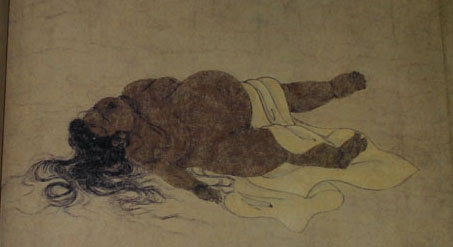Translated and Sourced from Mizuki Shigeru’s Mujyara, A Diplomat in Japan, Part II: The Diaries of Ernest Satow, 1870-1883, Japanese Wikipedia, and Other Sources
To learn much more about Japanese Ghosts, check out my book Yurei: The Japanese Ghost
At the beginning of the Heian era, during the reign of the Emperor Saga, lived the Empress-Consort Tachibana no Kachiko (橘嘉智子; 786-850CE). A devout Buddhist and holy woman, Tachibana founded the great Buddhist temple complex and learning center of Danrin-ji, and because of this was known as the Empress Danrin.
All of her life the Empress wanted to use her position and education to forward and spread the teachings of Buddha. But she had one major problem—Tachibana no Kachiko was cursed with a beautiful face. So much so that whenever she tried to teach people of the Buddha and warn them of the impermanent nature of life, she found herself constantly assailed by love letters and obscene offers instead of interested students . Even when she went to the mountain retreats to practice ascetic disciplines amongst the holy brothers—those who should have been spiritually armored against the temptations of flesh—the unwanted attentions were never ceasing.
This troubled Tachibana deeply. She knew that the beauty of her face and body were nothing; mere illusion that would fade and disappear. Yet with everyone so distracted by her transient beauty, how could they learn about the deeper truths of eternity? It was a question that would cloud her entire existence.
When the Empress died at the age of 64—still beautiful—her last will and testament was opened, and shocked the entire royal family. Instead of a state funeral and proper internment, the Empress requested that her body be garbed in the simplest cloth, then flung onto the streets. When people saw her delicate flesh rot away, the meat of her body picked at by crows and wild dogs, and her beautiful body reduced to unlovely bones, at last they would understand the impermanence of things and perhaps learn the lesson she had been trying to teach them.
And that is exactly what happened. The body of the Empress Tachibana no Kachiko was flung onto a dirty street in Kyoto, where it slowly rotted away and was picked at by crows and wild dogs. The body was dressed only in a simple katabira—the white kimono worn by Japanese corpses—and so the street where her body lay became known as the Katabira no Tsuji – The Crossroad of Corpses. Although many have forgotten the reason, the name remains and you can still go to Katabira no Tsuji today (Stop B1/A9 on the Arashiyama and Kitano lines in Kyoto).
Translator’s Note:
Another grim tale for Halloween, but one that involves no actual ghost. In fact, according to Japanese tradition it would be impossible for Katabira no Tsuji to be haunted because the Empress got exactly what she wanted—she would have no lingering attachments or resentments keeping her tied to the living world. But you have to love the gruesome image, and the story that goes with it.
Katabira no Tsuji was included in Takehara Shunsen’s Yokai Catalog, the Ehon Hyaku Monogatari (絵本百物語; Picture Book of a Hundred Stories).
There is slightly more to the story. The devout Empress Tachibana no Kachiko’s final act did not go unnoticed, and started an entirely new kind of Buddhist painting known as Kusozu (九相図; The Nine Signs). These paintings juxtapose scenes of a person beautiful and alive with the nine stages of their corpse as it decomposes. These pictures were extremely realistic, and obviously drawn from studies of actual corpses decomposing over time.
Kyuaizu were generally painted of famous, beautiful woman to show how their charms and wonders were nothing more than rotting flesh and death—only the soul mattered. The honored courtesan Onono Komachi was a popular subject of Kyuaizu, which lead to some mixing between her story and the story of the Empress Tachinbana.
Ernest Satow, a diplomat stationed in Japan, was being shown around Kyoto in the late 1800s when he related this story in his diary:
“Passed Katabira ga Tsuji where the body of Onono Komachi was flung out to be devoured by kites. Kukakusa no Shosho made love to her and was refused. She promised to be his if he would visit her first during 100 continuous nights. He walked 3 ri there and 3 ri back, but when the 100th night came she was from home.”
This blog shows the Kyuaizu of Komachi in its entirety.
Stage 1 – Still Living (生前相)
Stage 2 – Freshly Dead (新死相)
Stage 3 – Filled with Gas (肪脹相)
Stage 4 – Consanguinity (血塗相)
Stage 5 – Flesh Rot (肪乱相)
Stage 6 – Discoloration (青瘀相)
Stage 7 – Food for Beasts (噉食相)
Stage 8 – Skeletal (骨連相)
Stage 9 – Nothing but Dust (古墳相)
Further Reading:
For other death customs of Japan, check out:














Oct 31, 2013 @ 18:49:49
wow that one is really impressive and touching, Kachiko must have been a very interesting person in real life.
but it’s strange it passes for a kaidan when there really is no mysterious or supernatural elements involved in it…
Oct 31, 2013 @ 19:18:30
I agree. It is gruesome, but not mysterious or supernatural. But remember, the word kaidan only means “weird tales” and while they are mostly supernatural, sometimes they are just … weird. Or gory. Or something to freak you out.
Dec 29, 2015 @ 03:37:13
Kyuaizu sounds like coursip drawing or paining, and does not get along with
nine stages or phases of decomposition after death.
The three Chinese characters 九相図 should be atriculated 九相 図、
not 九 相図;the former reads either kyusou-zu or kusou-zu.
I’ve found an article, where they read the three Chinese characters “kusouzu.”